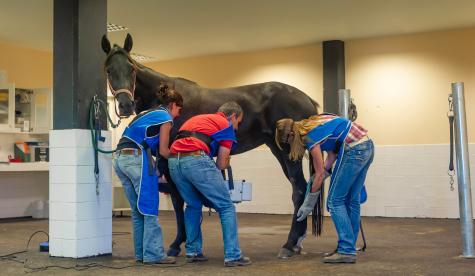Worming foals & young horses

Controlling worms in foals and young horses is important.
The immature immune systems of foals and young horses make them far more susceptible to worms than older animals. Some worm species are very common in young horses but rarely seen in older horses as they develop a natural immunity as they age. Young animals are also more susceptible to damage caused by worms due to their smaller size. Immature lungs and digestive systems are easily damaged by migrating worms, and a worm burden that may not cause a problem in an adult horse can easily block the gut of a foal.
Ascarids. The worm most dangerous to young horses.
The large roundworm or ascarid primarily affects horses less than two years of age. Ascarids are the most significant parasite in young horses because they are such large worms and can quickly develop into life threatening numbers. Ascarids have the potential to cause liver damage, which is repairable, and lung damage, which is permanent.
The ascarid life cycle.
Each female ascarid can lay 100,000 to 200,000 eggs each day. The eggs pass out with the horse’s faeces. Infective larvae develop within coated eggs, which are not affected by adverse weather conditions and can remain viable for up to 10 years. When the egg is ingested its coating is digested in the horse’s stomach. As the eggs reach the small intestine they hatch and the larvae immediately penetrate the lining of the intestinal tract, beginning a 30 day migration. It is important to remember that faecal egg tests do not detect migration of parasite larvae within the horse.

![Ascarid-liver-damage.jpg]() Liver damage by ascarid larvae.
Liver damage by ascarid larvae.
The larvae travel by the hepatic vein to the liver, where they eat their way around the liver for seven to ten days. Fortunately, the liver is a very resilient organ and can regenerate itself. Permanent damage to the liver from ascarid larval migration is seldom seen.
The ascarid larvae migration continues.
The larvae then travel to the lungs and continue their migration for 14 to 21 days, again eating their way around lung tissue. Unlike the liver, damage done to the lungs is permanent as lungs heal by scarring and so do not regenerate. After the ascarids mature and are ready to complete migration they burrow from the blood side of the lung into the air side.
Lung damage from ascarid larvae migration.![Lung damage from ascarid migration]()
A microscopic look at normal lung tissue shows empty air spaces, the alveoli, where oxygen is exchanged for CO2. When migrating ascarid larvae are present, the immune system violently reacts to the foreign protein and destroys the alveoli. Suchdamage predisposes foals to pneumonia and may result in pulmonary haemorrhaging in a horse that intended to become an athlete. The worms then crawl from the alveoli into the bronchioles, to the bronchi and then into the trachea. They cause enough irritation to elicit a cough so that they are coughed to the back of the throat and are re-swallowed as mature larvae. As adults they swim upstream in the small intestine, robbing the horse of nutrition. Once the larvae reach the small intestine for the second time, their presence there is of relatively little consequence to the horse unless they are allowed to develop into large numbers that can cause life threatening blockages of the intestines, especially in foals.
Protect your young horse’s lungs.
When a horse is just a few months old it has all the lung tissue it is ever going to have. Because lung tissue heals by scarring, damage to these sensitive structures is permanent with less functional lung available for the horse to utilise. Horses whose lungs have been damaged by ascarid larval migration may have to breathe harder and faster to meet their oxygen demand as they develop and are asked to perform.
Ascarid larval migration can also lead to other diseases. It reduces overall thriftiness in foals and can be related to pneumonia in foals. Ascarid larvae may have an immunosuppressive effect in the lung, reducing the ability of the horse’s immune system to respond to foreign invaders like bacteria and viruses.
Understanding mectin resistance and ascarids.
Unfortunately, it appears ascarids are the worm species that has developed resistance to the mectins. Ascarid resistance to mectins has recently been documented in Australia.
Resistance has also been documented in several countries overseas and some studies cite failures of multiple types of “mectin” chemical, so it appears that cross resistance to all “mectins” has occured. In the overseas studies, pyrantel was used effectively to control the worms.
The best way to treat and control worms in young horses.
To protect young horses from potential mectin resistance, it is recommended that a combination product registered to treat mectin resistant ascarids, such as Equimax© Elevation or Strategy-T©, be used. Young horses should be wormed with Strategy-T in spring and summer and Equimax Elevation in autumn and winter from twelve weeks of age until they are two years old. At this stage they can be put on the Equimax/Strategy-T rotation.

